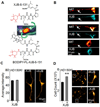Targeting of XJB-5-131 to mitochondria suppresses oxidative DNA damage and motor decline in a mouse model of Huntington's disease
- PMID: 23122961
- PMCID: PMC3513647
- DOI: 10.1016/j.celrep.2012.10.001
Targeting of XJB-5-131 to mitochondria suppresses oxidative DNA damage and motor decline in a mouse model of Huntington's disease
Abstract
Oxidative damage and mitochondrial dysfunction are implicated in aging and age-related neurodegenerative diseases, including Huntington's disease (HD). Many naturally occurring antioxidants have been tested for their ability to correct for deleterious effects of reactive oxygen species, but often they lack specificity, are tissue variable, and have marginal efficacy in human clinical trials. To increase specificity and efficacy, we have designed a synthetic antioxidant, XJB-5-131, to target mitochondria. We demonstrate in a mouse model of HD that XJB-5-131 has remarkably beneficial effects. XJB-5-131 reduces oxidative damage to mitochondrial DNA, maintains mitochondrial DNA copy number, suppresses motor decline and weight loss, enhances neuronal survival, and improves mitochondrial function. The findings poise XJB-5-131 as a promising therapeutic compound.
Copyright © 2012 The Authors. Published by Elsevier Inc. All rights reserved.
Conflict of interest statement
The authors have declared that no conflict of interest exists.
Figures




References
-
- Ayala-Torres S, Chen Y, Svoboda T, Rosenblatt J, Van Houten B. Analysis of gene-specific DNA damage and repair using quantitative PCR. In: Doetchst P, editor. Methods: A Companion to Methods in Enzymology. New York: Academic Press; 2000. pp. 135–147. - PubMed
Publication types
MeSH terms
Substances
Grants and funding
- P30 AG024827/AG/NIA NIH HHS/United States
- GM066359/GM/NIGMS NIH HHS/United States
- R01 NS062384/NS/NINDS NIH HHS/United States
- R01 NS040738/NS/NINDS NIH HHS/United States
- GM067082/GM/NIGMS NIH HHS/United States
- NS060115/NS/NINDS NIH HHS/United States
- AR051456/AR/NIAMS NIH HHS/United States
- AI068021/AI/NIAID NIH HHS/United States
- AG024827/AG/NIA NIH HHS/United States
- G12 MD007600/MD/NIMHD NIH HHS/United States
- P20 CA103730/CA/NCI NIH HHS/United States
- R01 NS060115/NS/NINDS NIH HHS/United States
- R01 ES020766/ES/NIEHS NIH HHS/United States
- CA092584/CA/NCI NIH HHS/United States
- U19 AI068021/AI/NIAID NIH HHS/United States
- ES016114/ES/NIEHS NIH HHS/United States
- P01 CA092584/CA/NCI NIH HHS/United States
- G12 RR003051/RR/NCRR NIH HHS/United States
- R01 AR051456/AR/NIAMS NIH HHS/United States
- P50 GM067082/GM/NIGMS NIH HHS/United States
- NS40738/NS/NINDS NIH HHS/United States
- NS062384/NS/NINDS NIH HHS/United States
- R01 GM066359/GM/NIGMS NIH HHS/United States
- R01 ES016114/ES/NIEHS NIH HHS/United States
LinkOut - more resources
Full Text Sources
Other Literature Sources
Medical
Molecular Biology Databases

